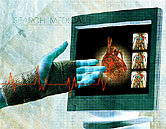
TUESDAY, May 15 (HealthDay News) — After patients undergo heart procedures to open blocked arteries, it may not be useful to give them treadmill stress tests with echocardiograms if they don’t have symptoms such as chest pain or shortness of breath, a new study suggests.
“There are very large populations of post-angioplasty and post-bypass patients; screening asymptomatic patients probably isn’t useful,” said lead researcher and cardiologist Dr. Thomas Marwick, of the Cleveland Clinic.
Identifying at-risk patients doesn’t improve their outcomes even if they have another procedure, Marwick added. “We can identify risk better than we can treat it,” he said.
Heart problems after these procedures are common and include impaired blood flow to the heart and worsening heart function, the researchers noted.
Guidelines of the American College of Cardiology/American Heart Association recommend stress imaging tests in symptomatic patients after revascularization, but testing patients without symptoms “is more controversial,” the researchers noted.
The report was published in the May 14 online edition of the Archives of Internal Medicine.
To determine the effectiveness of stress testing after revascularization, Marwick’s team gave echocardiogram stress tests to 2,105 patients who didn’t have symptoms.
Among these patients, 40 percent had previous heart attacks, 54 percent had an angioplasty and 46 percent had bypass surgery to open blocked heart arteries.
The test revealed that 262 patients were at high risk for a heart attack. Of these, 88 had another procedure to unblock arteries.
Over almost six years of follow-up, 97 patients died. These deaths were associated with heart problems whether patients had stress tests early — less than two years after an angioplasty or less than five years after bypass surgery — or later following a procedure.
“Importantly, patients identified as high risk did not have more favorable outcomes if they had repeat revascularization,” Marwick said.
The researchers concluded that a routine stress test that evaluates exercise capacity is sufficient to identify at-risk patients.
Standard stress tests involve monitoring a patient’s blood pressure during exercise.
Dr. Gregg Fonarow, a professor of cardiology at the University of California, Los Angeles, commented that “there has been increased interest in whether the used of stress testing in asymptomatic patients with coronary artery disease after revascularization procedures can detect individuals at increased risk of subsequent events and be used to improve clinical outcomes.”
This new study showed that in patients without symptoms, exercise echocardiographic stress testing did identify patients both early and late after revascularization at double the risk of dying, he said.
“Given that this testing provides independent prognostic information, further studies are needed to determine whether the findings from this testing is or is not useful for improving clinical outcomes,” Fonarow said.
Stress testing combined with imaging can cost between $800 and $2,400 per test. “So, determining the comparative effectiveness of managing asymptomatic patients with or without stress testing is of considerable importance,” he said.
More information
The U.S. National Heart, Lung, and Blood Institute has more about types of stress testing.

